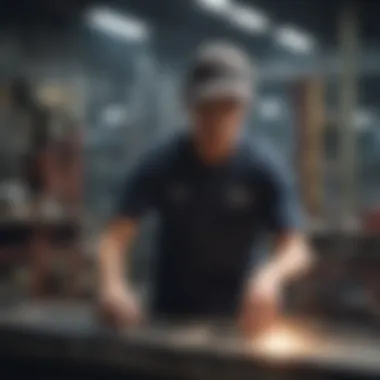Exploring Career Opportunities for Sheet Metal Workers


Intro
The field of sheet metal work offers a unique blend of craftsmanship and technology. Sheet metal workers shape and assemble various metal sheets into functional items used in various industries. This profession is essential not only for manufacturing but also for construction, HVAC systems, and automotive areas. Given the evolution of technology and the increasing demand for sustainable and adaptable metal products, understanding the options within this career path is crucial.
This article outlines vital aspects of being a sheet metal worker, from required skills to anticipated market trends. The aim is to equip readers with insights that help navigate their careers in this field.
Market Insights
Current Trends and Developments
The sheet metal industry has steadily integrated new technologies. Factors like automation, computer-aided design (CAD), and precision manufacturing techniques play a crucial role. Workers now frequently use tools like CNC machines, which allow for high accuracy in shaping metal. Moreover, the push for sustainable practices influences product development, pushing for lightweight materials and inventive designs.
Market Analysis and Predictions
Industry forecasts indicate growth in construction and manufacturing sectors, which are key employers for sheet metal workers. As cities continue to expand, the need for efficient HVAC installations in new buildings creates ample opportunities. Research shows that electricians often overlap in their skills with those of sheet metal workers, presenting potential job opportunities in related areas.
The leap towards sustainability means adopting greener practices, which might alter traditional workflows in metal fabrication but also open doors to new markets.
Sector-Specific Insights
Each sector involving sheet metal produces distinct demands. For instance, the HVAC sector requires expert knowledge in specific guidelines for installation and regulations. In the automotive industry, sheet metal workers focus on lightweight solutions to boost fuel efficiency. Effective collaboration with engineers allows innovative designs, fulfilling strong consumer interest in sustainable products.
Closure
Through understanding the varying sectors, sheet metal workers can estimate where growth prospects lie. Efforts towards environmentally-friendly practices seem everlasting, catering to a market eager for innovation. This comprehensive overview aims to start the journey for aspiring sheet metal workers and interested investors alike.
Prologue to Sheet Metal Work
Sheet metal work is a crucial sector within the manufacturing and construction industries, offering essential services for equipment and system installation. Understanding the foundations of this work helps see its significance in daily applications, from HVAC systems to roofing. The realm of sheet metal is not only diverse but also evolving, making it imperative to explore this area thoroughly.
Definition of Sheet Metal Work
Sheet metal work involves creating, shaping, and assembling metal sheets into functional items using various fabricating techniques. The materials typically used include aluminum, steel, and copper, which provide different properties suited for diverse applications. Work can range from producing ductwork for heating and cooling systems to crafting decorative architectural features.
Continuation of Definition
Beyond mere fabrication, sheet metal work encompasses bending, cutting, and shaping processes. Common tools include shears, brakes, and welding equipment. Knowledge in this area means having the capability to turn flat metal sheets into three-dimensional forms, essential in industries such as automotive, aerospace, and construction.
The Role of Sheet Metal Workers
Sheet metal workers play a vital role in bringing designs from blueprints to tangible products. Their responsibilities not only require technical skills but also an understanding of collaboration with engineers and architects. They ensure that all fabricated components are built to specification, which directly impacts safety and performance within installations.
Delving Into Responsibilities
In addition to fabrication, sheet metal workers are often involved in the installation and repair of components in various settings. This may include installing HVAC systems in commercial buildings or conducting repairs on industrial machinery. With changing technologies, their role is continuously adapting to new methods and materials, inherently influencing job functions.
The skill set for sheet metal workers brings both an art and science to the job, linking creativity with practical execution.
Equipped with the understanding from these areas, both current workers and ambitions seekers can navigate the landscape of the trade more effectively, realizing the countless possibilities that lie in the field of sheet metal work.
Key Responsibilities of Sheet Metal Workers
The role of sheet metal workers encompasses various responsibilities that are critical to the functionality of construction and manufacturing projects. Understanding these key duties is essential for aspiring workers and companies involved in the industry. The responsibilities emphasize not only the technical skills required but also the collaborative aspects of the job.
Fabrication Processes
Fabrication is at the heart of a sheet metal worker's responsibilities. This process involves shaping metal sheets into functional components for various applications, like HVAC systems, roofing, and custom manufacturing. Workers begin by interpreting blueprints and specifications to determine the dimensions, shape, and type of metal needed. The worker must operate machinery such as shears, presses, and CNC routers to cut and form the metal.
Safety is paramount during this stage. Workers wear protective gear and follow strict safety protocols to prevent injuries. Noise, dust, and metal shavings are common elements aspects workers must manage. Proficient fabrication requires both technical skill and an understanding of material properties to ensure durability and compliance with industry standards.
Installation and Repair Tasks
Once fabricated, the components require careful installation. Sheet metal workers travel to job sites where they install ductwork, roofing systems, and various architectural features. These tasks necessitate a solid understanding of building codes and regulations. Accuracy is critical, as improper installation can lead to system inefficiencies or failures.
Repairs are another significant aspect that requires quick troubleshooting and problem-solving. For example, when a HVAC system is not functioning optimally, a sheet metal worker quickly identifies leaks or loose fittings and undertakes necessary interventions. This responsiveness is essential to workplace efficiency and customer satisfaction. It portrays the worker not only as a technician but as an essential problem-solver.
Quality Control Measures
Maintaining high standards through quality control is essential in sheet metal work. Workers implement measures that ensure compliance with safety and performance standards. During fabrication and installation, checking for defects or inconsistencies is crucial. This attention to detail often involves inspections at various stages of the process.


Documentation is vital here. Recording measurements, inspections, and test results helps in maintaining accountability and ensures that all work meets legal and safety requirements. Regular communication with supervisors or clients regarding any issues that arise contributes to the overall project transparency and success.
Necessary Skills for Success
A career in sheet metal working is complex, necessitating a mix of specialized talents and soft skills. These skills form the backbone of what makes one successful in this field. They are not just beneficial; they are crucial for maintaining high standards of workmanship, safety, and team dynamics.
Technical Skills
Technical skills are fundamentally important in sheet metal work. This covers a range of abilities, such as proficiency in operating machinery, understanding fabrication techniques, and familiarity with various materials—such as stainless steel, aluminum, and copper. The precision required in cutting, bending, and assembling metal workpieces cannot be overstated.
Knowing how to read and interpret blueprints is a key requirement. This is critical since it determines how well the project aligns with specifications. Sheet metal workers often use tools like plasma cutters and CNC machines, which demand a sound understanding of how to set them up and employ them efficiently.
Furthermore, regular updates on industry best practices and safety standards are necessary. This essentially ensures that the finished products are up to code and have no significant issues.
Interpersonal Communication
Sheet metal workers frequently operate within teams. Creating synergy among team members requires effective interpersonal communication. This includes being clear and direct when discussing tasks, listening to others’ suggestions, and incorporating quality feedback into one's work.
Effective communication also plays a significant role when interacting with clients or stakeholders. Translating technical language into easy-to-understand concepts can facilitate better project outcomes. Having the ability to manage conflicts and misunderstandings can also foster a more collaborative work environment. Interpersonal skills contribute significantly not just to individual performance but to the broader project objectives.
Problem-Solving Abilities
Every construction site has its unpredictability. Thus, problem-solving is one of the essential skills a sheet metal worker must cultivate. Encountering unexpected obstacles during installation or fabrication is quite common. The adeptness to promptly identify issues and determine practical solutions directly aligns with project continuity.
Having a structured approach to problem-solving can alleviate delays and resource waste. For instance, if a cutting machine fails mid-project, the ability to troubleshoot the issue or find alternative procedures is critical. Additionally, engaging in continuous learning after facing challenges can lead to more innovative strategies for future tasks, thereby enhancing one’s skill set continuously.
“Problem-solving is at the heart of what we do, we must be prepared for anything.”
— Industry Expert
Educational Pathways for Sheet Metal Workers
Educational pathways are vital for anyone aspiring to enter the field of sheet metal work. This profession requires a unique blend of skills and knowledge that can only be acquired through formal training and hands-on experience. Therefore, understanding these educational avenues can significantly enhance job readiness and overall competency in the field.
High School Preparation
A solid foundation in high school is essential for future success as a sheet metal worker. Students should focus on taking courses that strengthen their mathematical abilities and understanding of mechanical principles. Classes in drafting, computer-aided design (CAD), and physical sciences are beneficial.
Participation in technical education programs may also provide an edge. Many high schools offer shop classes where students can gain practical experience with tools and materials used in the trade. Engaging in extracurricular activities related to engineering or technology can further fuel interest and provide networking opportunities.
Moreover, it is important for students to develop good problem-solving and teamwork skills during high school. Both skills translate directly into the workplace.
Vocational Training Programs
Vocational training programs are essential stepping stones for aspiring sheet metal workers. These programs allow students to gain specialized training in a relatively short time. Many technical schools and community colleges offer courses specifically tailored to sheet metal work. During these programs, students learn about metal properties, fabrication techniques, and safety practices.
Courses often combine classroom instruction with hands-on experiences, such as:
- Sheet metal layout and design
- CNC machining
- Welding and soldering techniques
Completing a vocational program can not only equip graduates with relevant skills but also make them more appealing to potential employers.
Apprenticeships Opportunities
Apprenticeships represent a traditional yet valuable route into the sheet metal industry. These programs typically combine on-the-job training with classroom instruction, providing a comprehensive approach to learning. Apprentices rotate through various work environments to gain insights into different aspects of sheet metal work.
Usually lasting three to five years, apprenticeships allow participants to:
- Work under the supervision of experienced professionals
- Earn a wage while learning
- Acquire certification upon completion, which further enhances employability
Apprenticeships can often lead to secure employment after the program concludes. Connections made during this period can also facilitate future job opportunities.
Industry statistics indicate that a significant percentage of new sheet metal workers have undergone formal training through apprenticeships, reinforcing their value within the field.
Certifications and Licenses
Importance of Certifications
Certifications play a crucial role in the sheet metal industry. They serve not just as a testament to a worker’s skills but also enhance their credibility. For sheet metal workers, certifications can open doors to various job opportunities. Having a certification often signals potential employers that the candidate has met certain industry standards. This can be particularly important in competitive job markets.
Employers often prefer hiring individuals who have demonstrated a commitment to their craft through years of training and certification. Furthermore, many customers look for licensed and certified workers when hiring for specific projects, ensuring quality and reliability. Additionally, holding valid certifications can lead to increased job security and demand for the worker's services, confirming the investment in upskilling pays off.


Relevant Certification Programs
Several viable certification programs aim at enhancing skills and knowledge for prospective sheet metal workers. Below is a list of prominent certification programs:
- NCCER Certification: The National Center for Construction Education and Research offers credentials for craft professionals, pivotal in establishing levels of competence in the industry.
- SMACNA Certifications: The Sheet Metal and Air Conditioning Contractors’ National Association provides a recognition program for contractors focusing on skills related to heating, ventilation, and cooling installations.
- AWS Certification: The American Welding Society offers certification crucial for those workers focused on welding aspects of sheet metal work, affirming best practices and safety measures.
Considerations for Certifications
When pursuing certifications, it is important to consider factors such as:
- Certification relevance: Ensure it aligns with your career goals in the sheet metal industry.
- Renewal policies: Many certifications require periodic renewal, so you must account for ongoing education.
- Cost: Evaluate the costs involved, including study materials, tests, and potential retakes.
By selecting the right certification programs strategically, a sheet metal worker can significantly enhance their career trajectory.
Job Market Trends
The job market for sheet metal workers is a crucial aspect of understanding the profession. It reflects the current landscapes of opportunities available and highlights the factors shaping these realities. Observing trends in this market allows potential workers and investors to make informed decisions.
Current Demand for Sheet Metal Workers
As urban development expands and infrastructure grows, the demand for sheet metal workers remains sturdy. This demand is driven by various sectors including construction, HVAC (Heating, Ventilation, and Air Conditioning), and manufacturing. Specifically, as new buildings rise and older systems require modernization, sheet metal workers are central to the installation and maintenance of duct systems and various environmental controls.
“The U.S. Bureau of Labor Statistics projects job growth for sheet metal workers to be 4 percent from 2022 to 2032.”
In light of these projections, several key points highlight the landscape:
- Consistent Offerings: The number of construction projects typically creates a steady requirement for skilled sheet metal workers.
- Industry Competition: As more firms enter the field, the competition increases for qualified workers. This competitive landscape can be both appealing and challenging.
- Regional Variances: Urban areas generally experience higher demand compared to rural regions. Cities with ongoing investments in infrastructure will require a larger workforce.
These elements painted a broader picture of job availability while suggesting pathways for aspiring workers.
Impact of Technological Advances
Technological advancements intertwine significantly with job market trends for sheet metal workers. Modern tools and techniques continuously shape how these workers approach their tasks. Machine automation improves efficiency but also demands skilled operators who can work with them.
Examining the affect of technology leads to several considerations:
- New Tools and Techniques: digital tools, like 3D modeling software, assist in design plans and help in visualization before actual fabrication begins.
- Training Needs: workers must remain adept with evolving technologies. This trend places additional emphasis on education and vocational training programs.
- Efficiency and Quality: automation in manufacturing, such as laser cutting machines, boosts production speed and parts precision, making skilled labor essential.
The interaction between technological advancements and workforce demand sets the stage for transformations inherent in sheet metal work, illustrating both challenges and opportunities for those involved in or entering the field.
Salary Expectations
Understanding salary expectations is crucial for those considering a career in sheet metal working. This information equips potential workers with the knowledge to make informed decisions about their future employment. By exploring salary ranges, individuals can evaluate whether the rewards align with their personal and financial goals. Moreover, recognizing the factors that influence wages can help workers seek opportunities that maximize earning potential.
Entry-Level Salaries
Starting salaries for sheet metal workers vary significantly based on geographic location, level of training, and industry demands. Generally, entry-level positions offer salaries ranging from $30,000 to $45,000 annually. Workers often begin in roles where they assist more experienced colleagues, learning essential skills required for tasks such as installation, fabrication, or maintenance. Cities with a high demand for construction and manufacturing often provide higher salaries to attract talent, which can greatly influence starting wages.
According to recent labor statistics, some reported entry-level salaries in regions like California and New York have risen to upwards of $50,000 due to a booming economy and persistent labor shortages in these states.
Furthermore, apprenticeships might lead to quicker salary advancement once workers complete their training programs.
Factors Influencing Salary Levels
Several elements contribute to the variation in salary for sheet metal workers. These can be assessed as follows:
- Experience Level: As in most trades, wages increase with years on the job. Senior workers typically command much higher pay than entry-level peers.
- Geographic Location: Regional economic health and demand for skilled craftspeople significantly affect pay. High-cost-of-living areas tend to offer higher wages.
- Type of Industry: Pay can also vary by sector. For instance, sheet metal workers in aerospace or automotive sectors may earn more compared to those in residential construction.
- Certifications: Respect and enhancements on one’s resume provided by specialized certificates can influence earning potential and job roles.
- Union Membership: Workers affiliated with unions may enjoy better pay packages and job security due to collective bargaining agreements.
Understanding these dynamics empowers potential sheet metal workers to negotiate better salaries and look for opportunities in growing areas. Monitoring trends in the industry and continuous upskilling can help to stay competitive in today’s market.
For those interested in further enhancing their understanding of wages within this profession, visiting resources like Encyclopedia Britannica or labor statistics websites may provide additional valuable insights.
Advantages of a Career in Sheet Metal Work
The field of sheet metal work presents a unique set of advantages appealing to those seeking a practical and rewarding career. Understanding these benefits can offer a clearer perspective for individuals considering this profession.
Diverse Employment Opportunities
Sheet metal workers have access to various employment opportunities across different sectors. This is a vital aspect of the trade, as it encompasses roles in construction, heating, ventilation, air conditioning, automotive manufacturing, and aerospace industries.
Moreover, as buildings and machines become increasingly complex, the demand for skilled sheet metal workers continues to grow. They find jobs in companies specializing in metal fabrication, construction firms, and even renewable energy sectors, such as solar installations.


Several roles can define a career in this area:
- Fabrication Specialist: Conducts the production of metal parts used for various applications.
- HVAC Installer: Focuses on the installation of heating and ventilation systems, critical to modern constructions.
- Maintenance Technician: Ensures the ongoing operation and repair of sheet metal machinery.
Due to this variety, workers can tailor their careers to areas they find most fulfilling. Hence, choosing sheet metal work often opens more doors than initially expected.
Potential for Career Advancement
Another significant advantage in the sheet metal industry is the potential for career advancement. Starting as an apprentice or entry-level worker in sheet metal can lead to various opportunities. With the proper training and experience, individuals can progress into higher coordinating roles that oversee teams or complex projects.
Workers often have a pathway to move into the following roles:
- Lead Technician: Manages on-site operations and oversees project execution.
- Operations Supervisor: Responsible for the overall efficiency of production lines in facilities.
- Estimating Manager: Works with clients to assess project costs and timelines.
In an evolving market, employers equally value innovation and efficiency. Workers open to ongoing education and specializing in new technologies, such as automation or advanced design software, often hold favorable positions. In this manner, the capacity for growth in the sheet metal sector is substantial, allowing dedicated individuals to cultivate their careers over time.
In summary, the career in sheet metal work holds unparalleled employment diversity and potential for advancement, making it a lucrative choice for aspiring professionals.
Challenges in the Sheet Metal Industry
Understanding the challenges within the sheet metal industry is crucial, not only for current professionals but also for those considering this career path. It highlights the realities of the job and the landscape in which sheet metal workers must operate. Moreover, addressing these challenges can lead to improved strategies for career resilience and adaptability.
Physical Demands of the Job
The physical nature of sheet metal work cannot be understated. Workers engage in tasks that often require strength, stamina, and precision. Lifting heavy materials, standing for long hours, and maneuvering equipment contribute to a physically demanding environment. This type of labor can lead to personal strain over time. In fact, it is common for sheet metal workers to experience musculoskeletal issues such as back and joint pain. As sheet metal work involves awkward postures and repetitive movements, ensuring proper ergonomics and regular breaks is essential. Additionally, prospective workers should consider these physical demands as part of their readiness for this career.
Job Security Concerns
Job security in the sheet metal industry is influenced by various factors, including economic trends and technological advancements. While there is a demand for skilled sheet metal workers, fluctuations in construction projects or manufacturing shifts due to automation can create instability. Workers may face periods of reduced hours or even layoffs during economic downturns or shifts in industry regulations. Furthermore, the increasing role of technology introduces new forms of machinery and production methods, leaving some workers to navigate potential workplace changes. It is vital for sheet metal professionals to continually upgrade their skills and adapt to trends to mitigate these concerns. Ultimately, understanding the job security landscape prepares individuals for a more stable career journey.
Future Outlook for Sheet Metal Workers
The future outlook for sheet metal workers is a critical topic, as it shapes understanding of the profession and its sustainability. With technology advancing and industry needs changing, it’s important to assess job growth and evolving technologies in relation to this field. Analyzing both aspects gives a scope of where the industry is heading and potential benefits for newcomers entering this trade.
Projecting Job Growth
According to labor trend analysis, the market demand for skilled sheet metal workers is projected to experience a steady increase. Reports suggest a growth rate between four to ten percent over the next several years. Factors contributing to this growth include:
- Infrastructure development: As cities expand and maintain existing structures, sheet metal fabrication is essential for air conditioning, heating, and ventilation systems.
- Green building trends: This movement towards more energy-efficient building practices often requires skilled workers to handle metal fabrication intricately involved in newer technologies.
- Real Estate Growth: Both residential and commercial properties continue to rise, creating ongoing demands for services associated with sheet metal work in construction.
With these factors at play, the prospects for finding employment in the field look favorable in near future. Staying informed about job market predictions helps those considering a career in sheet metal work make educated decisions about their training and professional pathways.
Evolving Technologies and Their Effects
Technological advancements have a profound effect on the sheet metal industry, impacting both design and manufacturing processes. Several new technologies have emerged, and their use shapes how work is carried out, leading to better efficiency and precision. Notable impacts include:
- CAD software: Computer-aided design systems enhance design capabilities, allowing for complex shapes and precision not previously possible with manual methods. Workers need to adapt to these digital tools to create accurate designs for fabrication.
- Laser cutting and CNC technology: These technologies offer remarkable accuracy, significantly reducing waste and time. As a result, workers proficient in such machines are increasingly valuable in the job market.
- Automation: Automated systems can streamline production, yet also emphasize the need for workers knowledgeable in both manual skills and technology skills for setup and maintenance.
Adapting to these evolving technologies is crucial. Workers who embrace continuous learning will keep pace with these industry changes and enhance their relevant skills. Ultimately, this knowledge advantages current and future employees, providing an avenue for growth within the profession.
Networking and Professional Development
Networking and professional development are crucial components for success in the sheet metal working industry. As this profession evolves, the need for strong professional ties and consistent skill enhancement grows. Engaging with others in this field not only opens doors to new opportunities, but is also essential for staying current with industry standards and practices.
Importance of Industry Connections
Establishing connections with other professionals can serve various purposes. Firstly, these connections can provide access to job opportunities that may not be advertised publicly. Many jobs are filled through referrals or word of mouth, highlighting the significance of networks.
In addition, connections can strengthen knowledge sharing. Interacting with skilled workers allows for the exchange of insider information about different fabrication techniques and newest technologies. This can be particularly beneficial for newer workers seeking to learn and fit in quickly in this competitive field.
- Networking aids in mentorship development. More experienced workers can offer valuable advice and practical knowledge to those at the start of their careers.
- Collaborating within professional networks can foster a sense of community, which is vital in any trade. This feeling of belonging can deliver greater job satisfaction and ongoing motivation.
The End
The importance of the conclusion in this article cannot be overstated. Summarizing key insights not only recaps essential information but also provides clarity on the subject of sheet metal work. This enables readers to grasp the industry's nuances, understand its demands, and appreciate the pathways to success.
Summary of Key Points
In this article, we covered many aspects within the realm of sheet metal work. Below are some critical points:
- Definition and Role: Sheet metal work deals with shaping and fabricating metal into various forms. Workers in this field possess ample skills needed to efficiently craft these materials into usable products.
- Responsibilities: Daily tasks frequently involve fabrication processes, installations, repairs, and stringent quality control measures. Attention to detail is paramount within these operations.
- Skills Needed: Technical abilities form a substantial part of a sheet metal worker's toolkit. Interpersonal communication and problem-solving are also invaluable for fruitful collaboration and navigating challenges.
- Education and Certification: Given the complexity of the role, educational training via vocational programs or apprenticeships can significantly enhance employment opportunities. Relevant certification further substantiates a candidate's expertise.
- Market Trends: Current demand persists for skilled workers, accompanied by an ongoing impact from technological advancements driving efficiency and precision in the trade.
- Job Security and Advancement: While the industry provides diverse career paths, it also has its challenges, like job demands and concerns about wage stability. Yet, those who are prepared can find advantage in the ever-evolving landscape.
Encouragement for Prospective Workers
For those contemplating a career in this field, there lies substantial opportunity. The existing landscape is ripe for individuals willing to invest in their skills and education. As you move forward, consider both the challenges presented and the considerable reward that comes in return. Diligent pursuit can lead to a stable and compelling career.
In summary, understanding sheet metal work may open doors. It could be the difference as you make informed career decisions that align with your personal and professional goals. Embrace the possibilities this evolving industry has to offer.



